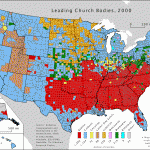Recently painter Thomas Kinkade, “painter of light” passed away at the early age of 54. While many viewers have decided views of what they think about this art, whether it suits them or not, one thing is certain: his work was decidedly informed by his faith. Kinkade had a particular theology about his art work and tried to convey his understanding of his faith through his art.
Kinkade’s passing coincided with my preparation for a class session on understanding religion and race. One of the themes I begin with is to ask students what Jesus and Mary look like. To this day, many students might remember seeing a Thomas Kinkade painting at a doctor’s office or in the hall of some academic or religious building. 
But many more students recall seeing Warner Sallman’s “Head of Jesus” painting. Believe it or not, this painting was done in 1941, as World War II ravaged Europe and Asia. America at that time was still largely white, with its largest racial minority population being African American, with no other competing minority. So at that time it would not be surprising that Sallman’s Jesus looked like a young-ish white male with a beard and long hair. As many have noted, he essentially appears as a middle class male when you trim his hair and beard. This is not surprising since Jesus embodies divinity made imminent – “God for us.” So it’s not surprising that God, as imaged in Jesus, tends to have the features of the artist’s understanding of how God is accessible to him or her. As such, Jesus looks white since race often matters even to white artists. Similarly Mary, as an advocate for believers tends to appear like the people who visualize her.

What gets interesting then is how Jesus and Mary appear when Christianity shows up after the “new immigration” of 1965. Immigrants from Latin America and Asia started arriving in numbers far larger than were known before. Most of those who migrated have been Catholic or Protestant, and in some cases were a larger religious group compared to their presence in their home country. For example, there are proportionally more Taiwanese American Christians compared to Taiwanese Christians. Did Jesus look like them? If the earlier observation is consistent we would guess that Jesus appears as Asian and Latino to many new immigrants coming from these parts of the world.
Indeed I found some examples of how Jesus and Mary are depicted in some of these other nations.
But reality is a lot messier than many of these assumptions. For many Christians in Asia and Latin America their main encounter of Christianity came through missionaries from the US, the largest sender of these kinds of religious workers. Not surprisingly, most of these workers are white and non-Hispanic. But interestingly many were presented with a Jesus that looks like the missionaries and less like the indigenous people. This incongruity did not deter many from converting of course, but it bears considering what is happening when someone sees God embodied in Jesus and racially resembling the missionaries. It makes sense that many might make subtle associations between the culture of the missionaries as somehow being more godly since God looks more like them.
 Recent evidence suggests that this might not entirely be the case. In a comparison study of South Korean and US Christian college students, it turns out that respondents understand Jesus’ character in different ways. One of the more striking differences is that Jesus is happy in the minds of the US Christians, but he is more sober and serious to the Korean students. We don’t know how these students were shown Jesus growing up but it seems that the students impose their cultural temperamental traits regardless.
Recent evidence suggests that this might not entirely be the case. In a comparison study of South Korean and US Christian college students, it turns out that respondents understand Jesus’ character in different ways. One of the more striking differences is that Jesus is happy in the minds of the US Christians, but he is more sober and serious to the Korean students. We don’t know how these students were shown Jesus growing up but it seems that the students impose their cultural temperamental traits regardless. 
What’s more is how these dynamics travels back to the US context. Imagine these believers now migrating to the US and raising their kids with their faith. How is Jesus pictured for these young non-white children? ![]() It’s been a question in my mind as I reflected on my own growing up experiences in Catholic and Protestant environments. I knew logically that Jesus was not from Europe but pretty much every image I saw of Jesus was white. I wonder if non-white Christians who have had similar experiences tend to make associations between Jesus’ race and the culture that surrounds them which is largely white. Does their ethnicity seem subtly inferior since Jesus was not Korean, Chinese, Colombian or Mexican? We know consciously that Jesus isn’t white and yet our most consistent image of Jesus is. What do you think?
It’s been a question in my mind as I reflected on my own growing up experiences in Catholic and Protestant environments. I knew logically that Jesus was not from Europe but pretty much every image I saw of Jesus was white. I wonder if non-white Christians who have had similar experiences tend to make associations between Jesus’ race and the culture that surrounds them which is largely white. Does their ethnicity seem subtly inferior since Jesus was not Korean, Chinese, Colombian or Mexican? We know consciously that Jesus isn’t white and yet our most consistent image of Jesus is. What do you think?













